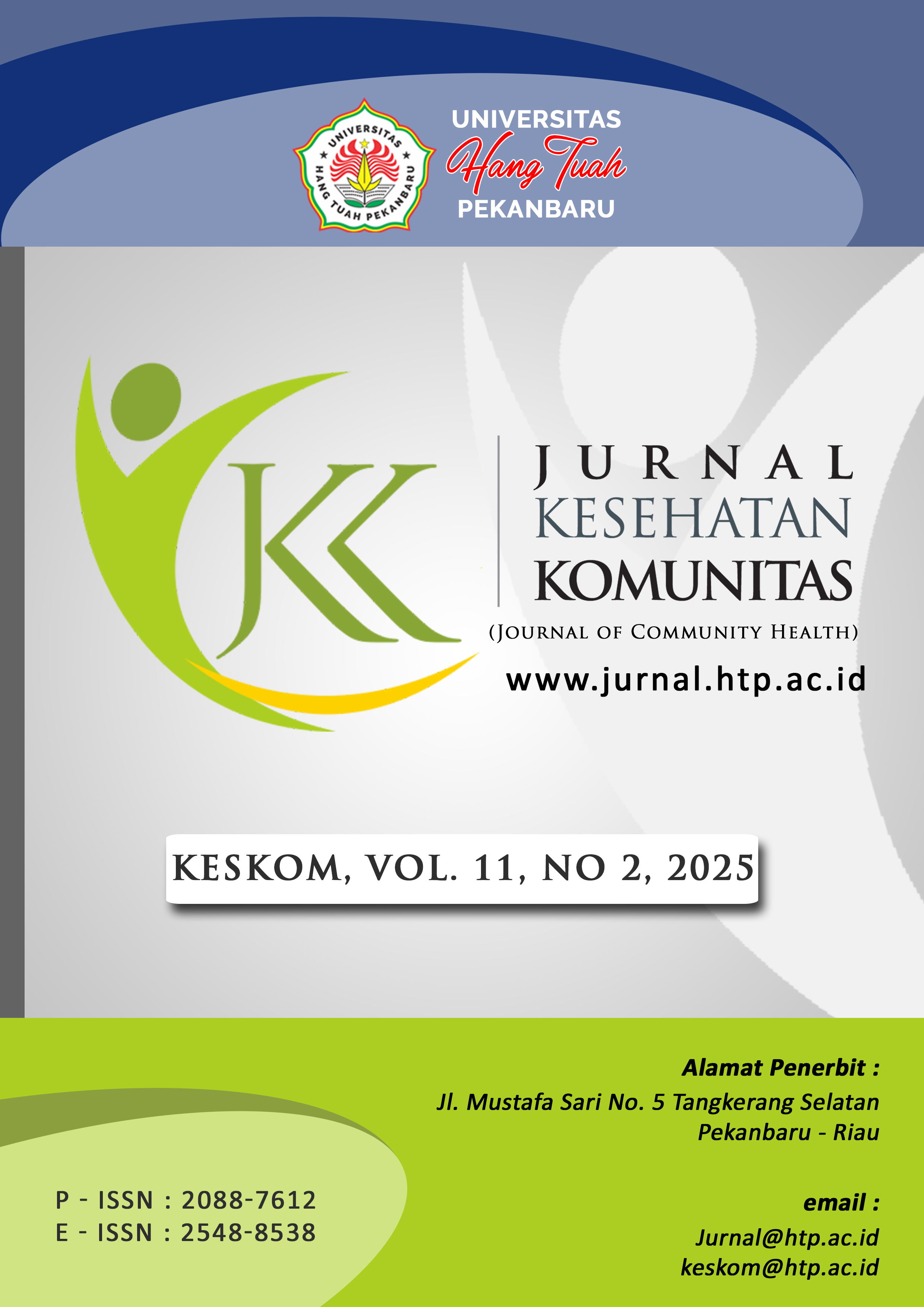The Relationship between Energy Intake and Macronutrient Intake on the Incidence of Obesity in Adolescents
DOI:
https://doi.org/10.25311/keskom.Vol11.Iss2.2036Abstract
The prevalence of obesity in Pekanbaru City among adolescents aged 16-18 years in 2018 was 4.87%. Obesity in adolescents is mainly caused by excessive food intake. The purpose of this study was to determine the relationship of energy intake and macronutrient intake to the incidence of obesity in SMA Negeri 2 Pekanbaru. This type of research is descriptive analytic research with cross-sectional design. The research sample was 44 respondents obtained using stratified random sampling technique. Data collection used food recall questionnaires and anthropometric measurements. Data analysis used the spearman correlation test. The results showed that 29.5% of respondents were obese, 56.8% had excess energy intake, 75% had excess protein intake, 72.7% had excess fat intake, and 56.8% had excess carbohydrate intake. The results of bivariate analysis showed that there was no relationship between energy intake (p=0.068), protein intake (p=0.085), fat intake (0.081), and carbohydrate intake (0.068) with the incidence of obesity in adolescents. It is expected that health workers provide education about balanced nutrition to students so that optimal nutritional status for adolescents can be realized.
Downloads
References
[1] Pemayun TGAD, Budhitresna AAG, Permatananda PANK. Gambaran Tingkat Aktivitas Fisik dan Kejadian Obesitas pada Civitas Akademika Universitas Warmadewa , Bali. J Pendidik Tambusai. 2022;6(2):8526–32.
[2] Kemenkes RI. Hasil Riset Kesehatan Dasar Tahun 2018. Kementerian Kesehatan RI. 2018;53(9):1689–99.
[3] Pratama BA. Literature Review: Faktor Risiko Obesitas Pada Remaja Di Indonesia. Indones J Med Sci. 2023;10(2).
[4] Kemenkes. Pedoman Umum Gentas Gerakan Berantas Obesitas. 2017;1–41.
[5] Sholichah F, Aqnah YI, Sari CR. Asupan Energi dan Zat Gizi Makro Terhadap Persen Lemak Tubuh. J Ilm Gizi dan Kesehat. 2021;2(02):15–22.
[6] Khoerunisa D, Istianah I. Hubungan Asupan Zat Gizi Makro dan Aktivitas Fisik dengan Status Gizi pada Remaja. J Pangan Kesehatan dan Gizi Univ Binawan. 2021;2(1):51–61.
[7] Amrynia SU, Prameswari GN. Hubungan Pola Makan, Sedentary Lifestyle, dan Durasi Tidur dengan Kejadian Gizi Lebih pada Remaja (Studi Kasus di SMA Negeri 1 Demak). Indonesia J Public Health Nutr. 2022;2(1):112–21.
[8] Andi Paraqleta Nur Eli, Nurhikmawati, Irmayanti, Safei I, Syamsu RF. Hubungan Aktivitas Fisik dengan Kejadian Overweight pada Tenaga Kependidikan di Universitas Muslim Indonesia. Fakumi Med J J Mhs Kedokt. 2023;2(12):914–22.
[9] Yanti NKDW. Hubungan Pola Konsumsi Jajanan dan Aktivitas Fisik dengan Obesitas pada Remaja di SMPN 1 Kuta. 2023;13(2):94–100.
[10] Harvard T.H. Chan School of Public Health. The Nutrition Source: Obesity and Overweight. [internet; cited by 21 August 2024]. Available from: Obesity – The Nutrition Source (harvard.edu)
[11] Mayo Clinic. Obesity: Causes. [internet; cited by 21 August 2024]. Available from: Obesity - Symptoms and causes - Mayo Clinic
[12] Centers for Disease Control and Prevention. Overweight and Obesity. [internet; cited by 21 August 2024]. Available from: About Obesity | Obesity | CDC
[13] Irwanda M, Suryani D, Krisnasary A, Yandrizal. Gambaran Asupan Energi, Zat Gizi Makro dan Status Gizi Remaja di SMP N 14 Kota Bengkulu Tahun 2022. ASKARA J Ilmu Pendidik Nonform. 2023;09(01):199–208.
[14] Micha, R., Peñalvo, J. L., Cudhea, F., Imamura, F., Rehm, C. D., & Mozaffarian, D. (2017). Association Between Dietary Factors and Mortality From Heart Disease, Stroke, and Type 2 Diabetes In the United States. JAMA, 317(9), 912-924.
[15] Yurisna, Sattu M, Lanyumba FS, Otoluwa AS. Gambaran Asupan Gizi Makro, Vitamin D Dan Aktivitas Fisik Pada Remaja Obesitas Di SMP Kota Luwuk Tahun 2022. Bul Kesehat Mhs. 2023;1(2):61–8.
[16] Telisa I, Hartati Y, Haripamilu AD. Faktor Risiko Terjadinya Obesitas Pada Remaja SMA. Faletehan Heal J. 2020;7(03):124–31.
[17] Habsidiani RA, Ruhana A. Tingkat Konsumsi Gula dan Lemak antara Remaja Obesitas dan Non Obesitas Usia 15-18 Tahun di SMAN 1 Kota Mojokerto. 2021;2016.
[18] American Heart Association. Dietary Guidance to Improve Cardiovascular Health: A Scientific Statement From the American Heart Association. 2021;144; 472-487.
[19] National Institute of Diabetes and Digestive and Kidney Diseases. Understanding Adult Overweight & Obesity [Internet]. 2023 [cited by 2024 August 20]. Available from: Understanding Adult Overweight & Obesity - NIDDK (nih.gov)
[20] Putri AZZ, Mayesti Akhriani, Alifiyanti Muharramah, Abdullah. Hubungan Tingkat Kecukupan Lemak dan Karbohirat dengan Status Gizi pada Remaja Putri. J Gizi Aisyah. 2023;6(1):85–90.
[21] Hall, K.D., et al. Energy Expenditure and Body Fatness in Humans. Obesity Reviews. 2012;13(S2), 43-51. DOI:10.1111/j.1467-789X.2011.00963.x.
[22] Slavin, J.L. Dietary Fiber and Body Weight." Nutrition, 2008;24(8), 804-812. DOI:10.1016/j.nut.2008.04.005
[23] Speakman, J.R. "The Calories in–Calories Out Dilemma: How to Keep the Body From Gaining Weight." Nutrition Reviews. 2008;66(2), 27-32. DOI:10.1111/j.1753-4887.2007.00061.x.
Downloads
Submitted
Accepted
Published
How to Cite
Issue
Section
License
Copyright (c) 2025 Jurnal kesehatan komunitas (Journal of community health)

This work is licensed under a Creative Commons Attribution-NonCommercial-ShareAlike 4.0 International License.
Copyright @2017. This is an open-access article distributed under the terms of the Creative Commons Attribution-NonCommercial-ShareAlike 4.0 International License (http://creativecommons.org/licenses/by-nc-sa/4.0/) which permits unrestricted non-commercial used, distribution and reproduction in any medium












































